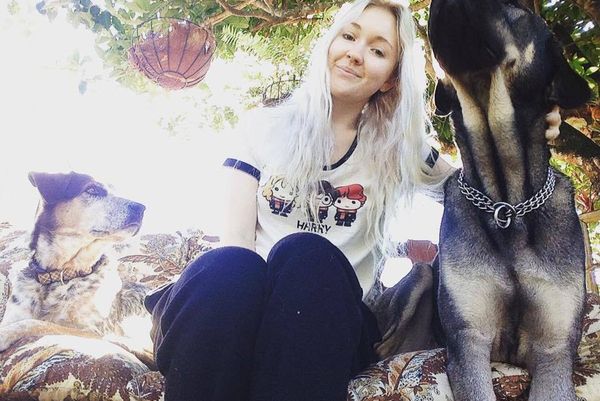
Of course it starts with spring. Sunlight slides in a sheet under the back door. In the bush there’s wattle, waratah and a milky way of flannel flowers. In the garden there are blossoms: plum, apple, cherry and dogwood. The air feels softer. Sometimes, it snaps back to cold and snows, and people rush up from Sydney to take photos. Then the blossoms fall and we’re on our way.
We moved to Katoomba in the Blue Mountains in the late 90s, economic escapees from Sydney. I found the first few winters hard but the summers glorious. At 100km from the coast – and 1000m higher – we don’t get the southerly buster, but our summer storms are spectacular and bring the same radical drop in temperature. I kept a record in the first year: 35C to 16C, 30C to 12C. After a day of summer heat, the house is warm but you can open the windows to a river of cool air, a shriek of cockatoos, the smell of eucalyptus.
Our kids were born in the mountains and have never lived anywhere else. Mountains kids can’t handle the heat: 25C and they’re slumping round the house moaning, 27C and they’re begging to switch the air conditioning on. They’re sensitive to all the things we took for granted in our Sydney childhoods (mosquitoes, sunburn, bindi-eyes), and relaxed about all the things that were strange to us (snakes, snow and endless days of dripping mist). A change of location hasn’t changed my attitude to huntsman spiders, which are plentiful and generously sized up here. The kids have learned a healthy fear of them from their mother. By “healthy” I mean that when I see a huntsman I close the door, run for my partner, and wait at the end of the garden while he does his thing with the broom. There are plenty of funnel webs in the garden and I don’t like them either, but they don’t rush across your windscreen when you’re doing 80km on the Great Western Highway.
Summer in the mountains means snakes sprawled across bush paths and sometimes footpaths. The ones we see most often are copperheads, black snakes and diamond pythons. Summer means hearing the striped marsh frogs in our neighbours’ pond calling time on the day with their knocking and tapping, like someone trying to attract your attention through a closed window. Summer means wattle birds in the banksia, our blue tongue lizard coming out of hibernation. This year we’re seeing a record number of butcher birds; during lockdown the black cockatoos took charge of the skies. When it’s a cicada year there are thousands of them, the sound like a knitting needle in the ear, although there’s only two kinds up here: a Yellow Monday wearing a black mask, and a tiny, fly-like Floury Baker.
Summer means dinner at the pool. There isn’t much to “do” in the mountains if you don’t like being outside, but our local pools are alive on a summer evening. If it was too hot to cook, too hot to be in the house, I’d make falafel rolls and buy a watermelon, and we’d head up to Katoomba pool to meet our friends. We had 14 kids in our gang and they looked after each other. We’d loll on the grass and feel the cool of the evening start to steal in or sit with our legs dangling in the baby pool, keeping an eye on the toddlers.
I can’t talk about summer without talking about the catastrophic weather we keep seeing; the catastrophes that caused it, the catastrophes that follow it. We’ve lived through many bushfire seasons in the mountains, but no Australian will ever forget the summer of 2019. For us, it was yellow sky and grass, the streets eerie and empty of tourists, the air filled with endless sirens. Standing on clifftops at night watching orange fire lace itself along the ridges. Then flooding rains. There was a landslide over the train line to Sydney and my oldest child couldn’t travel to their first semester of uni. What happened next? Let’s not talk about it.
Thinking about our kids makes me look forward, not back. I’m hopeful. The Blue Mountains has many First Nations custodians living on country, Darug and Gundungurra people whose custodianship is the mainstay of our community. There’s good news: the raising of Warragamba Dam wall in the already flooded Burragorang Valley has been put on hold, a move that will preserve art and sacred space as well as endangered species and their World Heritage habitat. For the record, the wall proposal was a Coalition initiative. I used to wonder what Scott Morrison would think if I submerged his church in a trillion litres of water.
Katoomba means “water tumbling over a hill”. If you’ve stood on a ridge deep in the Blue Mountains national park you’ll be able to hear a few things. A whipbird cracking. The shuffle of a snake or a lizard somewhere in the scrub. The sound of a companion breathing. Waterfalls rushing in the distance. If it’s summer you’ll pull your shoes off and stand in a stream, watching yabbies and tadpoles, or walk down further into the valley where the air is cool. Or maybe you’ll just head to Katoomba pool and lie on the grass listening to the joyful shouts of kids bombing one another as the hot day softens into night.
Tegan Bennett Daylight is the author of Royals, a novel for teenagers







